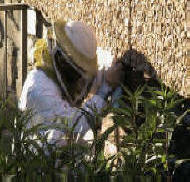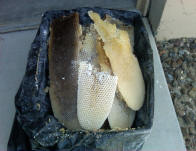|
|
|
|
||||||||||||||||||||||
|
Home - About Us - Services - Birds - Bees - Wildlife - Products - Projects - Faq - PMP - Help - Links - Contact Us |
||||||||||||||||||||||||
|
Guaranteed Bee removal & honey comb removal services & wasp removal are available in metro Phoenix and the surrounding cities only.
* 60 Day Guarantee good if access is sealed up within 10 days
KILLER BEES HAVE BEEN KNOWN TO FOLLOW SOMEONE OVER A 1/4 MILE AND YOU CAN'T OUT RUN THEM !
EXPERTS AGREE THAT THE BEST METHOD OF ESCAPING AN ATTACK IS TO COVER YOUR HEAD AND RUN FOR COVER GET INSIDE A CAR, HOUSE OR SOMEPLACE THAT THE BEES CAN'T GET INTO - DON'T JUMP INTO A POOL OR STAND AND SWAT AT THE BEES - JUST RUN.
Bee Removal services are offered in: Anthem, Avondale, Ahwatukee, Chandler, Mesa, Tempe, Glendale, Phoenix, Scottsdale, Paradise Valley, Peoria, Gilbert, Surprise, Sun City, Sun City Grand, Goodyear, Litchfield Park, Tolleson, Cave Creek, Queen Creek, El Mirage, Youngtown, Sun City West, Buckeye, Guadalupe, Fountain Hills, Carefree. Arizona
|
Phoenix Honey Bee Removal, Killer Bees & Wasp
|
|||||||||||||||||||||||
|
|
|
|
| Bee hive that was 50' up in the canopy of a pine tree |
Without all the bees, you can see how massive this bee hive really was. Honey comb sections were 3" thick |
Bees will build their comb around just about anything that's in the way, here they built in and around the pine cones |
What generally happens after our bee removal or bee control treatment -
If we have just performed a bee removal or treatment service for you we would tell you that you may expect that some bee activity could continue for the next 24 to 72 hours as returning bees come home and find the hive has been treated or is gone. A common occurrence is that you may even find that the bees are not going into the treated opening but are collecting on the side of a wall or bush near the treated opening or site in what some people describe as a softball size clump of bees. Please call us after the 48 - 72 hours if after that time, you still have bee activity.
Most of the products that we use for bee removal pr bee control are generally low or non-toxic to humans and animals and are usually not harmful to your property.
There may be an
opening that the honey bees originally entered through like a hole in the soffit. This needs to be sealed on the outside after the honey bees have left or died off. We can do this at
an additional charge, but it is usually simple for the homeowner to do
themselves with some caulking.
be sealed on the outside after the honey bees have left or died off. We can do this at
an additional charge, but it is usually simple for the homeowner to do
themselves with some caulking.
It is possible for another bee swarm to move into some other area of your property at any time, however it is unusual for a residential property to have a frequent reoccurring problem with honey bees unless the property is near a wash or the open desert. Sometimes residual honey comb in the wall can attract more bees, or the honey can melt creating damage to the wall or drywall and then attracts other pests and insects, causing other problems.
Most honey bee swarms are removed in time, but if needed, we can perform a honey comb removal service at an additional charge after the honey bees or killer bees are completely gone. Some locations that we need to do a tear out of the wall may require you to arrange for restoring the wall and retexturing.
Africanized Killer Bees in many cases require treatment after dark to remove or stop the threat of attack. Killer Bees are much calmer at night and it is safer for the surrounding inhabitants and pets.
EUROPEAN HONEYBEES are what you are use to seeing when you think of
bees. They live in colonies made of wax. Honey bees can last for many years at a
single nest site, becoming semi-dormant during the winter months. Honey bees feed on
nectar and pollen. Honey Bee are an extremely important and beneficial insect due to
its production of honey and other products, as well as pollination of most plants.
However, when honey bees nest inside of a wall or are creating a threat to humans or
animals, unfortunately the only route is destruction in most cases.
If you encounter a honey bee swarm (bees collecting together outside on a wall or in a
tree), many times they move on within 24 - 72 hours. If at all possible, leave them
alone and they will most likely leave you alone. When honey bees are swarming, they
are usually migrating and are just resting. If it is close to the end of the day, and
they stay overnight on your property, they will probably be quiet and still in
the dark and will generally move on in the morning. If they are aggressive, please see
next section and call us for assistance.
AFRICANIZED HONEYBEES (popularly known as "killer bees") are not something to take lightly. Looking just like our domestic honey bee, their behavior is quite different. Killer bees frequently attack people and animals who unwarily stray into the territory they defend around their nests. Unforeseen stinging attacks have sometimes resulted in serious injury or death. Though their venom is no more potent than that of our common European Honey bee, Africanized killer bees respond in greater numbers and pursue intruders for greater distances. Also, disturbed colonies may remain agitated for as long as 24 hours. Any person or animal in the patrolled area is vulnerable. The nest itself need not be disturbed. Africanized Bees have responded ferociously to everyday occurrences such as vibrations generated by passing vehicles, power equipment and even foot traffic, many landscapers discover the bees when they do the yard work using mowers and blowers which create noise and vibrations.
A little history on
Africanized killer honey bees (AHB) they
were first discovered in Arizona when a colony, established in the roof of a
Tucson house, stung a small dog to death on 6 June 1993. Experienced
beekeepers and federal and state scientists who examined the remains of the
colony suggested the colony was between 4 and 8 months old, placing its
arrival into the state possibly as early as October, 1992. This was the
second state in the U.S., after Texas, to confirm the natural spread from
Mexico of this non-native species.
By the end of 1993, the Arizona Department of Agriculture had recognized 57
AHB colonies from central and southern Arizona. Ten of the AHB colonies
detected were involved in stinging incidents, none leading to human
fatalities. By midyear 1995, 95 AHB colonies had been detected, 28 involving
stinging incidents.
Then the first human fatality from AHB in Arizona occurred on Oct. 6th. 1995,
east of Phoenix, when an 88 year old woman was stung over 1000 times. A
second fatality, a 66 year old man stung approximately 130 times, occurred
only 12 days later, also near Phoenix. Elderly people are at greater risk
from the bee venom.
Africanized honey bees are the result of
crossbreeding between European and African strains of honey bees. In the
1950's, Brazilian geneticists reasoned that bees from tropical Africa might
be better suited for the climate of tropical South America than were the
European honey bees, whose performance was disappointing.
Unfortunately, Africanized bees were released from the breeding program
before selective breeding was completed against the stronger defensive
behavior which characterizes African bees. The AHB has taken to its new
environment with vigor. They spread prodigiously since their release, with
the leading edge advancing of up to 300 miles per year through the tropics
of South and Central America. Meanwhile, but few colonies of AHB turned up
in the U.S., accidentally transported on shipments of materials from South
and Central America
program
before selective breeding was completed against the stronger defensive
behavior which characterizes African bees. The AHB has taken to its new
environment with vigor. They spread prodigiously since their release, with
the leading edge advancing of up to 300 miles per year through the tropics
of South and Central America. Meanwhile, but few colonies of AHB turned up
in the U.S., accidentally transported on shipments of materials from South
and Central America
The first time that a swarm of AHB was verified to have entered the United
States on its own was in Hidalgo, Texas in October, 1990. The bees have since
spread north and west through Texas and northern Mexico and currently is
known to be in the 4 states bordering Mexico. Many sharply different
predictions have been made as to how far AHB will eventually spread into the
US. Fortunately the initial rapid expansion seems to have slowed.
Abridged from an article in California Agriculture 51:22-25. For further
reading: the complete version of this article appears at the university site
of one of the co-authors, entomologist, Kirk Visscher.
|
|
|
|
|
Just a few bees flying around a water irrigation box could really be a big problem under the lid |
PLEASE NOTE: WE ARE NOT DOCTORS
- THIS IS FOR GENERAL INFORMATION PURPOSES ONLY AND NOT MEANT TO
TAKE THE PLACE OF COMMON SENSE OR PROFESSIONAL MEDICAL ADVICE.
Localized swelling and pain are typical reactions to a sting by a wasp or bee.
These symptoms gradually disappear within a few hours in most people. When stung
by a honeybee, the stinger generally is left behind. Carefully remove it by
scraping across the stinger with a credit card so that the small attached poison sac is not squeezed, which can force
more venom into the wound. Some kinds of bees and wasps do not leave a stinger.
RULE OF THUMB
- 10 stings per pound of body weight - CALL FOR HELP & SEE A DOCTOR NOW !!
you could be in danger of
death as your different organs could start to shut down because of the bee
venom, people have died from far less stings. Small children and the
elderly are the most likely people to have a problem with multiply stings.
The sting site on a small area of the body may be treated with an antiseptic to prevent possible infections.
Cool lotions or compresses can help relieve pain and swelling. Crushed aspirin
or powdered meat tenderized applied to the sting also can help reduce the pain.
If numerous stings are received, oral antihistamines can reduce swelling and
itching. Only take these with the usual precautions of this these products.
A small percentage of the U.S. population (approximately 1 percent) becomes
hypersensitive to bee stings and may suffer sever allergic reactions. This
includes difficulty in breathing, dizziness, nausea and development of hives and
swelling.
These "systemic" effects from a sting may require immediate medical attention
from a physician. An allergy specialist may advise a series of injections to
lessen sensitivity and some people may even need to have shots.
AFRICANIZED HONEYBEES, because of their inclination to attack aggressively and
in groups, will intensify this problem. Some individuals have been stung
hundreds of times in only a few moments. That alone is enough to cause a
reaction in someone that is not even allergic to bee stings. Most often, people
and animals who have died from Africanized bee stings have not been
able to get away from the bees quickly.
EXPERTS AGREE THAT THE BEST METHOD OF ESCAPING AN ATTACK IS TO COVER YOUR HEAD AND RUN FOR COVER, GET INSIDE A CAR, HOUSE OR SOMEPLACE THAT THE BEES CAN'T GET INTO - DON'T JUMP INTO A POOL OR STAND AND SWAT AT THE BEES - JUST RUN, THIS IS NOT MACHO MAN TIME !!

How honey bees establish colonies.
Honey bees are very social creatures that live in hives of up to 60,000 individuals. At certain times of the year like several weeks after it rains and the flowers start to bloom, the old queen will take part of the colony with her and separate from the new queen and the rest of the hive to fly out and look for a new home.
While on the move, this group of bees are called a swarm. The swarming bees sometimes rest in a large clump or group out in the open somewhere like on a wall or on a bush, tree branch, eaves of a home or even a car for 24 - 72 hours which is what a lot of people find when they come home from work and find a softball or football size clumps of bees around their home. Generally if the bees are in the open they will move on in 24 - 72 hours unless they found some place they can get the swarm moved into.
Once bees find a suitable place to live, the bees will begin to build rather quickly a multi-celled structure called a comb.
Any established colony of bees with comb and brood is much more defensive than a swarm that is just moving through looking for a home. Africanized and European honey bees both will defend their hive, but Africanized bees will do it much more aggressively and in greater numbers even chasing you 1/4 mile from the hive before giving up.Sometimes an entire hive of bees will leave or abandon an established hive which is called absconding which you may have read articles about called colony collapse where bee just leave the hive for no reason that we know of.
|
|
|
|
| Honey comb & bees in garage wall | About 30 lb's of comb removed | And we can do dry wall repair |
How to prevent honey bee colonies.
Honey bees require three things in order to survive: food source, nearby constant water source and some type of shelter.
Honey bees use nectar and pollen from flowers as food. Honey bees will visit swimming pools, fountains, pet dishes or even livestock watering troths to drink water and also to gather water to take back to the hive.
Bees will nest in a wide variety of locations, such as animal burrows, overturned flower pots, cavities in saguaros, trees or rocks, irrigation valve boxes, drainage tiles, discarded automobile parts, old appliances, and yes in walls of homes.
Bee can enter openings as small as 3/16-inch in diameter as long as there is a suitable-sized cavity for building a comb behind or inside the opening.
A. Eliminate shelter.
To prevent bees you will need to be vigilant for potential nesting sites.-
Fill or cover all holes 1/8-inch in diameter or larger in trees, structures and block walls.
-
Caulk cracks in wall, pipe openings, meter boxes, around foundations and in roof openings.
- Check any where the chimney or room additions meets the house for separations.
-
Put window screening over drains and attic vents.
-
Remove any trash or debris that might serve as a shelter for bees, such as overturned clay pots, automobile parts tires, old appliances, cardboard boxes, barbeques, crates and pallets.
-
Fill or cover any rodent or animal burrows in the ground or going under a shed.
-
Try to keep shed doors tightly closed and in good repair as well as exercising caution when entering buildings like sheds or pool houses that are not used frequently.
B. Monitor water sources.
Sometimes adding about 2 tablespoons of vinegar per gallon of water helps to discourage bees from using your pet water or birdbaths.
Cover or drain above ground pools or hot tubs when not in use.
Removing flowers as a source of food is generally not effective nor recommended.
Individual bees gathering pollen and nectar from flowers should be left alone. Bees are very important to all of us because they pollinate many flowers and plants including most food crops such as citrus. Bees and other insect pollinators account for more than a third of our daily diet and without them life would be very different and food would cost a lot more than it does now.
C. Inspect your home and yard regularly for signs of and bee activity.
-
A few bees in your yard around a flower or fountain does not necessarily mean you have a colony of bees in your yard, bees can fly quite a distance in search of flowers, pollen or water.
-
You need to be looking for a large number of bees moving in and out or or even hovering in front of some type of an opening that leads to a void.
-
You need to look for colonies at ground level also like in water meters boxes or under sheds and pool equipment and even along the lower stucco edges of a home where they can get into spaces behind tubs and build outs or bay windows.
-
You need to be looking up in the trees, under the eaves or attic access of the house for bees.
If and when you should find an established bee colony around your home or property, move away from it and donít panic, but also don't ignore this potentially serious problem either.
Colonies of bees that have recently swarmed are generally docile at first, but over time may become much more defensive as time goes on and as they start to have something to defend like their hive. You should have any colonies or hives around your home or business removed ASAP. Be sure to keep any pets, children or neighbors away form the hive until it can be removed.
![]() Never try to remove a bee colony yourself!
Never try to remove a bee colony yourself!
Call Arizona Wings N' Stings immediately at 602-942 -6550
Copyright © 2011 Arizona Wings-N-Stings All rights reserved. Revised: 06/05/12.





